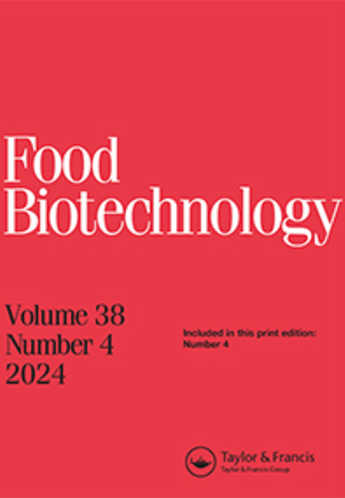Genome sequencing and flavor compound biosynthesis pathway analyses of Bacillus licheniformis isolated from Chinese Maotai-flavor liquor-brewing microbiome
IF 1.6
4区 农林科学
Q4 BIOTECHNOLOGY & APPLIED MICROBIOLOGY
引用次数: 11
Abstract
ABSTRACT Maotai- flavor liquor is one of the most popular distilled liquors in China that contains various flavor substances produced by a specialized brewing microbiome. Bacillus licheniformis is one of the major bacterial species in the Maotai-flavor liquor-brewing microbiome. However, the whole genome sequence of the B. licheniformis brewing strain has not been reported, which hampers further understanding of its effects on brewing. In this study, whole genome sequencing of B. licheniformis MT-B06 isolated from Maotai Daqu, a fermented wheat starter containing brewing microorganisms, was carried out using the Pacific Bioscience RS II platform. The sequence had a length of 4,440,765 bp with 45.7% GC content, encoding 5023 CDS sequences, 81 tRNAs, and 24 rRNAs. Next, genome annotation was performed based on four high-quality databases, including the COG, KEGG, GO/IPR, and Swiss-Prot databases. The genome sequence obtained was comparatively analyzed with that of B. licheniformis ATCC 14580, which is used for industrial enzyme production, which revealed that 69.95% of the differential genes are metabolically related, suggesting that these genes may be closely related to the flavor compounds biosynthesis. Therefore, the flavor compounds biosynthesis pathways and 26 relevant genes of B. licheniformis MT-B06 was analyzed, including alsS and alsD for 3-hydroxy-2-butanone synthesis, ispD, and ispE for terpenoids synthesis. This is the first report of high-quality whole genome sequencing of B. licheniformis MT-B06. Our results provide an important foundation for investigating metabolic pathways of desired compounds, such as C4 compounds and pyrazines, in Maotai-flavor liquor to improve its taste and quality.中国茅台味酿酒微生物群地衣芽孢杆菌基因组测序及风味化合物生物合成途径分析
茅台香型白酒是中国最受欢迎的蒸馏白酒之一,它含有由一种特殊的酿造微生物群产生的多种风味物质。地衣芽孢杆菌(Bacillus licheniformis)是茅台味白酒酿造微生物群中的主要菌种之一。然而,地衣芽孢杆菌酿酒菌株的全基因组序列尚未报道,这阻碍了对其酿酒作用的进一步了解。本研究利用Pacific Bioscience RS II平台,对从含酿酒微生物的小麦发酵剂茅台大曲中分离得到的苔藓芽孢杆菌MT-B06进行了全基因组测序。该序列全长4,440,765 bp, GC含量为45.7%,编码cd序列5023条,trna 81条,rrna 24条。接下来,基于COG、KEGG、GO/IPR和Swiss-Prot四个高质量数据库进行基因组注释。将获得的基因组序列与用于工业酶生产的B. licheniformis ATCC 14580的基因组序列进行比较分析,发现69.95%的差异基因与代谢相关,表明这些基因可能与风味化合物的生物合成密切相关。因此,我们分析了地衣芽孢杆菌MT-B06的风味化合物生物合成途径和26个相关基因,包括3-羟基-2-丁酮合成的alsS和alsD,萜类合成的ispD和ispE。本文为地衣芽孢杆菌MT-B06高质量全基因组测序的首次报道。本研究结果为研究香型茅台酒中C4类化合物和吡嗪类化合物的代谢途径以改善茅台酒的口感和品质提供了重要的基础。
本文章由计算机程序翻译,如有差异,请以英文原文为准。
求助全文
约1分钟内获得全文
求助全文
来源期刊

Food Biotechnology
工程技术-生物工程与应用微生物
CiteScore
3.80
自引率
0.00%
发文量
15
审稿时长
>12 weeks
期刊介绍:
Food Biotechnology is an international, peer-reviewed journal that is focused on current and emerging developments and applications of modern genetics, enzymatic, metabolic and systems-based biochemical processes in food and food-related biological systems. The goal is to help produce and improve foods, food ingredients, and functional foods at the processing stage and beyond agricultural production.
Other areas of strong interest are microbial and fermentation-based metabolic processing to improve foods, food microbiomes for health, metabolic basis for food ingredients with health benefits, molecular and metabolic approaches to functional foods, and biochemical processes for food waste remediation. In addition, articles addressing the topics of modern molecular, metabolic and biochemical approaches to improving food safety and quality are also published.
Researchers in agriculture, food science and nutrition, including food and biotechnology consultants around the world will benefit from the research published in Food Biotechnology. The published research and reviews can be utilized to further educational and research programs and may also be applied to food quality and value added processing challenges, which are continuously evolving and expanding based upon the peer reviewed research conducted and published in the journal.
 求助内容:
求助内容: 应助结果提醒方式:
应助结果提醒方式:


